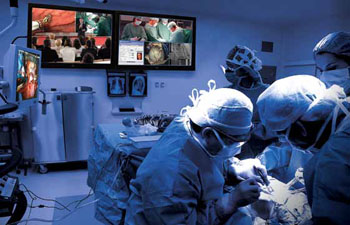Healthcare Facilities Adopt Video Streaming Technologies
Streaming video offers residents, fellows, and clinicians in training the option to witness procedures remotely instead of crowding into already busy operating theaters.
As streaming video grows increasingly prevalent as a training and communications tool, the healthcare market’s adoption of this technology is on the rise. Not only are hospitals utilizing video as a means of connecting medical professionals, it’s proving to be practical for patient education as well.
Tom Pfeuffer, vice president of the medical division at Haivision Network Video in Lake Forest, IL , notes that one of the benefits streaming video offers is the ability for surgeons to collaborate with each other in real time. “They can open up their operating rooms for remote visual so that they can talk to other surgeons, and those surgeons can now see inside their operating theater, allowing them to provide that collaboration in real time to help that other surgeon through the procedure,” he explained. Along the same lines, residents, fellows, and clinicians in training can witness procedures remotely instead of crowding into already busy operating theaters. “Being able to stream that procedure into a conference room or some other remote setting provides a tremendous benefit from a learning perspective.”
A recent mandate requiring teaching hospitals to be equipped with simulation labs also presents opportunities for integrators. “These facilities recreate an operating room environment or a procedure room environment, and students participate in mock procedures,” Pfeuffer explained. Overhead cameras and microphones record the simulation, and systems such as Haivision’s video over IP solution are used for encoding, decoding, recording, and playback.
South Western Communications, a systems integration firm based in Nashville, TN , is currently updating a trauma room system for a local teaching hospital. The system features an AV recording system integrated with VBrick video streaming technologies, enabling the trauma room staff to record procedures at the push of a button. “That video and audio is then streamed to a server that is recording all of these different sessions, and they utilize that video for teaching purposes,” explained Tony Hackett, senior account manager.
Hackett notes that his firm is observing a growing demand for streaming video to patient rooms—in some cases, to provide entertainment, but in many more, for educational purposes. “For example, I may have been in for open-heart surgery, and before I leave I need to watch these particular videos on how to take care of myself when I get home,” he illustrated. “I believe there is going to be a big market for that in the future, because we are seeing a lot of requests for that application.”
One of the challenges of incorporating streaming video into a healthcare facility is putting it on the network. “In the past, it was more common to have your own dedicated network for video,” Pfeuffer said, adding that in many facilities this remains the case. “One of the reasons that healthcare facilities are a little bit concerned about video on the network is because video on the network tends to require—especially in realtime— a high level of priority, and there are other critical systems on the network that need top-level priority.” A second dedicated network requires that facilities manage it separately, and today’s technology has progressed to the point where an existing infrastructure may be leveraged to support video without compromising other critical systems. “H.264 has gotten so efficient,” he said, “that it can be streamed very effectively over the network.”
Margin Builder
Selling streaming video into the healthcare market involves high-level conversations that include chief information officers and IT departments as well as other hospital executives. Tom Pfeuffer of Haivision advises integrators to make their sale two-fold: “Take the technical benefits and translate them into clinical benefits, that goes a long way,” he said. “Working with the clinicians is good, and it drives the demand for the product, but the IT department needs to be addressed, or it creates problems in the sales cycle.”
Carolyn Heinze is a freelance writer/ editor.
AV Must Talk IT
When it comes to incorporating technologies such as streaming, videoconferencing, and IPTV into healthcare facilities, it’s necessary for AV integrators to speak the IT professional’s language.
“You need to have someone who understands networks, ports, switches, routers, servers, and applications,” said Tony Hackett of South Western Communications. “The traditional AV installer that does Crestron or AMX boardrooms may not have the expertise required for this.” In larger facilities, the IT department generally handles the configuration of the network, but in smaller hospitals—that may not have an IT person on staff—this may not be the case. “In that situation, you may be more involved in setting the network up.”











